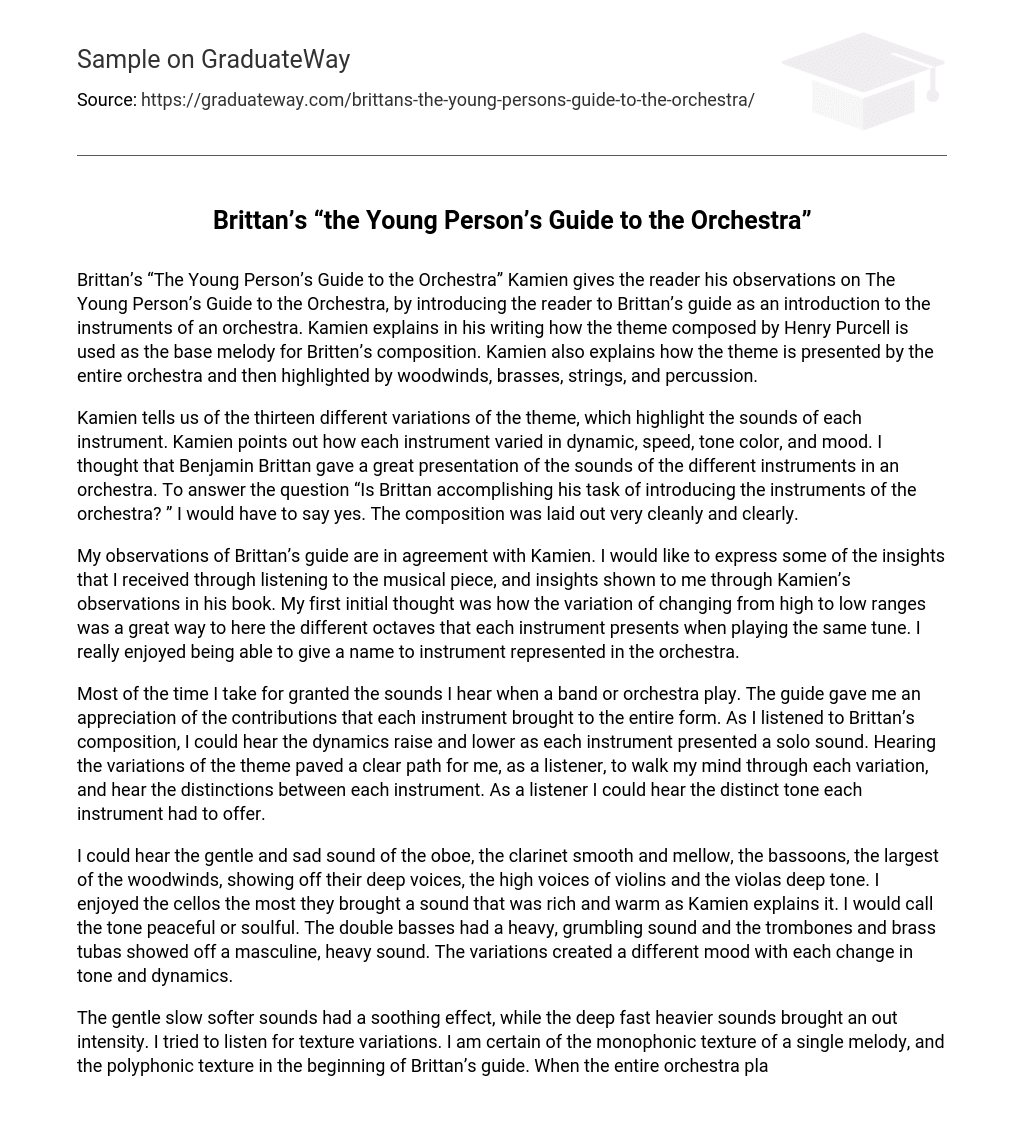Brittan’s “The Young Person’s Guide to the Orchestra” Kamien gives the reader his observations on The Young Person’s Guide to the Orchestra, by introducing the reader to Brittan’s guide as an introduction to the instruments of an orchestra. Kamien explains in his writing how the theme composed by Henry Purcell is used as the base melody for Britten’s composition. Kamien also explains how the theme is presented by the entire orchestra and then highlighted by woodwinds, brasses, strings, and percussion.
Kamien tells us of the thirteen different variations of the theme, which highlight the sounds of each instrument. Kamien points out how each instrument varied in dynamic, speed, tone color, and mood. I thought that Benjamin Brittan gave a great presentation of the sounds of the different instruments in an orchestra. To answer the question “Is Brittan accomplishing his task of introducing the instruments of the orchestra? ” I would have to say yes. The composition was laid out very cleanly and clearly.
My observations of Brittan’s guide are in agreement with Kamien. I would like to express some of the insights that I received through listening to the musical piece, and insights shown to me through Kamien’s observations in his book. My first initial thought was how the variation of changing from high to low ranges was a great way to here the different octaves that each instrument presents when playing the same tune. I really enjoyed being able to give a name to instrument represented in the orchestra.
Most of the time I take for granted the sounds I hear when a band or orchestra play. The guide gave me an appreciation of the contributions that each instrument brought to the entire form. As I listened to Brittan’s composition, I could hear the dynamics raise and lower as each instrument presented a solo sound. Hearing the variations of the theme paved a clear path for me, as a listener, to walk my mind through each variation, and hear the distinctions between each instrument. As a listener I could hear the distinct tone each instrument had to offer.
I could hear the gentle and sad sound of the oboe, the clarinet smooth and mellow, the bassoons, the largest of the woodwinds, showing off their deep voices, the high voices of violins and the violas deep tone. I enjoyed the cellos the most they brought a sound that was rich and warm as Kamien explains it. I would call the tone peaceful or soulful. The double basses had a heavy, grumbling sound and the trombones and brass tubas showed off a masculine, heavy sound. The variations created a different mood with each change in tone and dynamics.
The gentle slow softer sounds had a soothing effect, while the deep fast heavier sounds brought an out intensity. I tried to listen for texture variations. I am certain of the monophonic texture of a single melody, and the polyphonic texture in the beginning of Brittan’s guide. When the entire orchestra played they brought several melodic lines into a meaningful whole called a counterpoint. I really enjoyed the variation of the final concluding section. The tone color at this point became lively.
The dynamics begin in this section with the high-pitched instruments and fell to the low-pitched instruments. It was like a rollercoaster of sound. The composition was laid out very clearly. The theme was played as a whole by the orchestra, and repeated by each instrument with a solo. Variation was played so the listener could hear each sound the solo instruments were capable of. The whole orchestra came back together in at the end. They played together to show the end result of how the instruments work together to form a composition. Accomplished with their different tones, pitches, and dynamics.





